Q&A – Ask Neil: September 22, 2022
(Please read these instructions carefully.)
We’ve received really nice comments on this much-expanded way of addressing questions I’m asked. Before you post your own question, I might suggest you look at recent issues to see if someone else has already asked it. You might find your answer there.
How to submit your question…
• Click here to post your question.
• After you submit your question, a new window will pop up giving you the address to which you can e-mail a photo to accompany your question. Clear, medium-resolution photos. (Try to avoid low-res thumbnail photos, please, in case I have to zoom in to see things.)
• Please only post your question one time.
• One question per reader, please.
• Please use this only for posting questions – not for standard emails.
• Watch for your answer in the following week’s e-gardens.
• I choose those of greatest general interest. For example, plant IDs seldom make the cut.
• I must have your first name or initials.
• I must have your city or county. (Texas is a very large state.)
QUESTION 1
CAN 10-10-10 FERTILIZER BE USED?
Question: I bought some 10-10-10 fertilizer because it was on sale. Should I use it, or would it do more harm than good? Joyce R., Longview.
Answer: It all revolves around a soil test to show which elements are lacking in your soil. For most of Texas the middle number (phosphorus) is already present in excessive quantities, especially if we have been fertilizing already with a food that has any phosphorus in it. Phosphorus is slowly soluble in water, so it accumulates, particularly in clay soils eventually adding up to harmful levels. If you have sandy soil that is less likely to be a problem. The Soil Testing Lab at Texas A&M conducts nutrient tests on soils for a modest fee. That would be the best way to tell for sure. You could also ask your county Extension office for their estimate. For what it’s worth, some states won’t even allow the production or sale of fertilizers containing phosphorus. Perhaps you could take it back for a refund.
QUESTION 2
WILL GREEN GIANT ARBORVITAE COME BACK?
Question: We have had four beautiful Green Giant arborvitae for the past 8 years. Also two Emerald Green arborvitae. This summer, all of them turned brown and brittle. Will they come back? Charles M., Roanoke, Denton County.
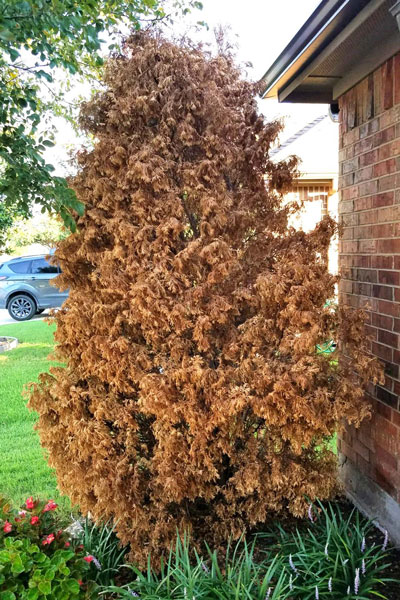
Answer: These varieties are challenging in the Texas heat, partly because they prefer the cool, moist climate of the Pacific Northwest and partly because of spider mites, their annual pests. The plant in your photo looks like it might have gotten too dry. Whatever the cause, sadly, it won’t come back. I’m sorry for that bad news.
QUESTION 3
WILL ST. AUGUSTINE RE-COVER FROM CHINCH BUG DAMAGE?
Question: This summer’s chinch bug damage was the worst I have seen in 30 years. Will I have to dig up the affected area and plant new sod, or can I spread a compost mix and let the runners refill? John M., Lewisville.
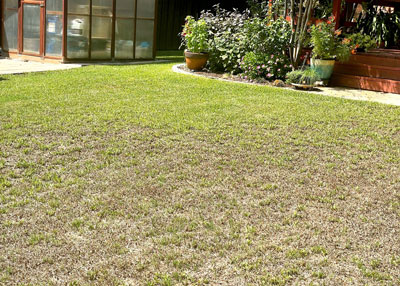
Answer: This is serious turf kill. Again, I have bad news. You’re going to have to replant this area. You could plant plugs into it checkerboard-style, or you could remove all the old sod in April or May and lay down new sod after running a rear-tine tiller across the area to break up the surface. Regarding adding a layer of compost, I’m not sure that would ever be a recommendation. Perhaps you’re thinking of the old suggestion of a 1-inch layer of sphagnum peat moss to combat take all root rot. Even that remedy, however, has been updated. Research has shown that the fungicide Azoxystrobin is far more effective. But – that is not your problem.
QUESTION 4
HOW DO I GET RID OF THIS WEED?
Question: How do I get rid of this feathery weed? I’ve applied pre-emergent, but perhaps not at the right time. I’ve tried pulling it, but it keeps coming back. It takes over our flowerbeds and other places every summer. Donald B., Garland.
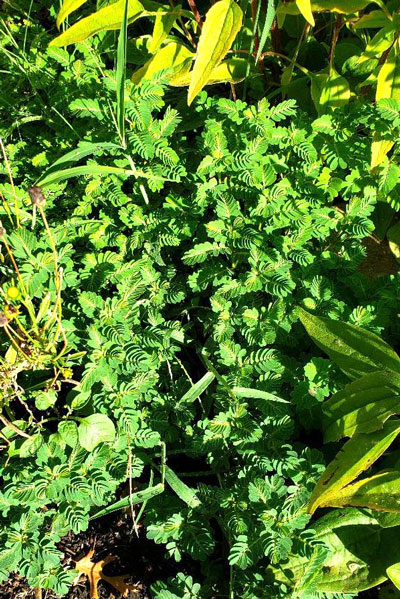
Answer: You could either use a roll-type mulch to cover the ground, then camouflaging it with bark mulch or compost, or you could apply a broadleafed weedkiller (containing 2,4-D) with a foam rubber paintbrush to the leaves while the weed is growing actively. Pre-emergents aren’t going to do the job, and pulling certainly won’t, either.
QUESTION 5
ISN’T THIS TOO EARLY FOR MY MEYER LEMON TREE TO BE BLOOMING?
Question: My Meyer lemon tree is covered with blooms. Isn’t this too late for it to make fruit? This same thing happened two years ago while it was inside. Small fruit fell off without maturing. Is the tree confused? Cindy P., San Antonio.
Answer: University websites will tell you that lemons bloom when they want to. This isn’t unusual. Remember that they are subtropical fruit crops, so they’re unaccustomed to freezing weather. The fruit that formed indoors on your tree two years ago may never have been pollinated during the blooming period. It aborted for that reason. Keep your tree outdoors as much of the time as you can to give bees access to the blooms.
QUESTION 6
WHEN SHOULD STAR JASMINE BE TRIMMED? BY HOW MUCH?
Question: When should I trim my 2-year-old star jasmine? How much should be taken from its height? Ondina M., Hood.
Answer: Without a photo I can’t really advise you, but I will say that there is no requirement saying that Confederate star jasmine must be pruned at all at any time. I have a plant that I’ve had in a very large pot for more than 20 years. It’s growing on a heavy 5-foot trellis, and it stands out about 30 inches from the trellis. I trim off any straggling stems when they show up (probably once every year or two). If I lived where my vine wouldn’t freeze, I’d have it on a much larger trellis where it could grow to be 15 or 20 feet tall. If it ever needed to be pruned and shaped, I’d aim to do that after the major spring bloom.
QUESTION 7
DO I HAVE TO REMOVE ROCKS TO PULL OUT NUT SEDGE?
Question: I have nutgrass coming up in beds with multiple crape myrtles. I have rocks in those beds. Do I have to remove the rocks to be able to pull the nutgrass? Sam P., San Antonio.
Answer: The weed isn’t a true grass, but instead a sedge. It has triangular stems, where grass stems are round. You don’t want to try to pull it out. Ever. The small “nuts” that it produces along its root systems break loose and help propagate new plants. You will have much better results if you use herbicides specifically intended for controlling nutsedge. Image is most common at consumer level, but it’s too late to use it this year. Sedgehammer is more common in the nursery and landscape contracting industry.
QUESTION 8
HOW AND WHEN SHOULD WE PRUNE A ROSE OF SHARON THAT WAS BEATEN UP BY A STORM?
Question: Please help us with a rose of Sharon that took a beating in a recent storm. We feel it is getting big and unruly and that we should cut it back before spring. How and when should we do so? Stephanie G., Heath.
Answer: Try not to prune it back any more than you must, hopefully no more than 25 or 30 percent. That can be done anytime now through early spring when it starts to leaf out. If it’s simply too large for the space you have for it, consider digging and replanting it where it would have more room. Transplanting would be done in winter.
QUESTION 9
WHAT IS BEST WAY TO GET PLUMBAGOS THROUGH WINTER HERE NEAR THE METROPLEX?
Question: Hearing you and Steve Huddleston of the Fort Worth Botanic Gardens talk about plumbagos, then seeing them in person at the Gardens, I bought several. What is the best way to care for them so they will survive the winters here in Johnson County? Debra B., Cleburne.
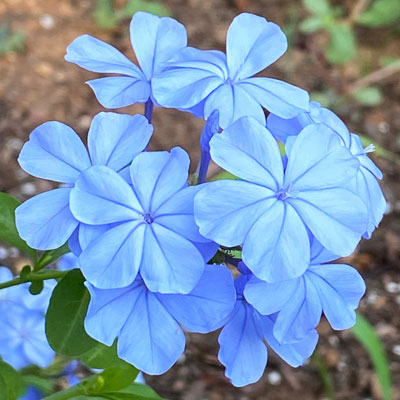
Answer: It would be best to keep them in pots and bring them into a greenhouse or similar structure when temperatures are going to drop below 28F. They just aren’t as hardy as you will need them to be to keep them outdoors in the winter.
QUESTION 10
WHY IS BERMUDA LAWN NOT ENTIRELY GREEN?
Question: I have a new home with bermudagrass planted last September 2021. It has never been entirely green. What is causing portions of it to be brown? What can I do in the future to avoid this? Chia L., Little Elm.
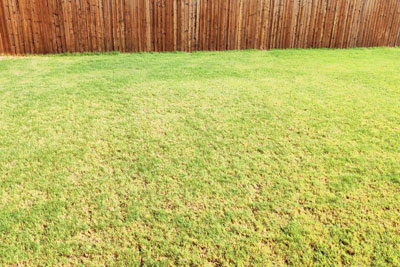

Answer: It is difficult from the distance of your photos to determine the exact cause. If the runners are stubby, it could be bermudagrass mites, although if your lawn was started from seed it would be unusual for mites to show up so soon. If you kept the lawn a bit on the dry side, or if you didn’t fertilize it very well, those shortages could cause this look. Keep mowing at 1-1/4 to 1-1/2 inch to keep the turf low and spreading. Apply an all-nitrogen fertilizer with 30 to 40 percent of the nitrogen in slow-release form. Apply it in your part of the DFW area in early April, early June, early August and early October.
QUESTION 11
WHAT IS THIS BLACK STREAK IN MY LAWN? IT SHOWED UP ALMOST OVERNIGHT.
Question: I encountered this black streak in my lawn almost overnight. There actually are several black patches, each 3 to 4 inches in diameter. What can I use to treat it? Bobby D., Austin.
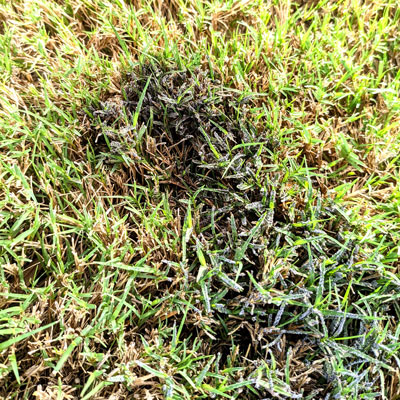
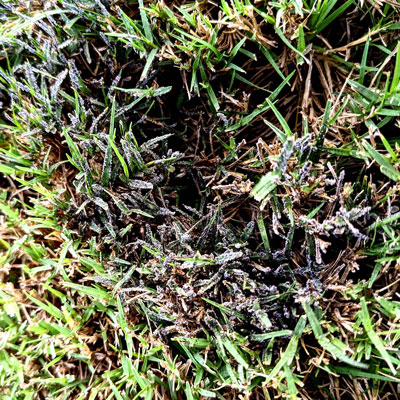
Answer: This is slime mold. As threatening as that name sounds, it’s actually a harmless fungus. About the only damage it will do to the turf is to shade it for a few days. It is a saprophytic fungus that lives off decaying organic matter in the thatch of the grass. We see it commonly in June. September is quite uncommon, at least in my experience. If you want to get rid of it you could apply dusting sulfur to it or you could blast the spores away with a very hard stream of spray water. Or you could just wait a few days and let them dry up and go away on their own.
